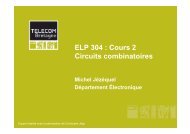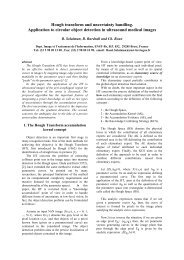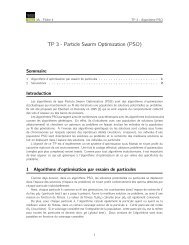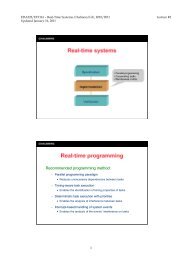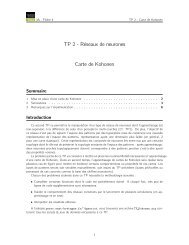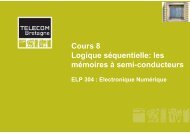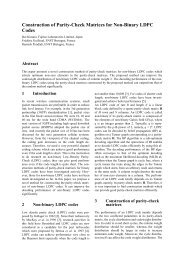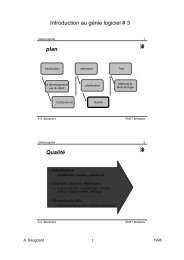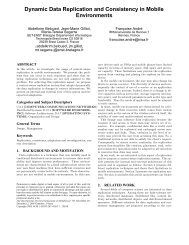A Quasi-Optical Free-Space Measurement Setup Without - Service d ...
A Quasi-Optical Free-Space Measurement Setup Without - Service d ...
A Quasi-Optical Free-Space Measurement Setup Without - Service d ...
Create successful ePaper yourself
Turn your PDF publications into a flip-book with our unique Google optimized e-Paper software.
BOURREAU et al.: QUASI-OPTICAL FREE-SPACE MEASUREMENT SETUP WITHOUT TIME-DOMAIN GATING 2025Fig. 5. 3-D EF (3) computed with α =0.1 for Rexolite material (h =12.85 mm) at 80 GHz.In order to obtain the actual permittivity, the following procedureis applied:a) The three-dimensional (3-D) evolution of EF is computedvarying the real part ε ′ r and imaginary part ε ′′r of ε r atone frequency point. This step provides initial estimatesof ε ′ r and ε ′′r which correspond to EF minima observed(see Fig. 5).b) One of these initial estimates of ε r is chosen and thepermittivity is then extracted by means of (3) at eachfrequency point over the whole frequency range.c) The calculated S-parameters at each frequency point arecomputed over the frequency range using the previouslyε r extracted values. The comparison between the calculatedand measured four S-parameters in magnitude andphase clearly shows whether the ε r extracted values areacceptable or not. If not, step b must be repeated usinganother initial value of ε r obtained from the first step.d) The thickness h can be precisely adjusted by comparisonbetween the S 11 and S 22 calculated parameters andmeasurements.Note that in c and d steps, the comparison is performedbetween the measured and calculated magnitudes of S 11 andS 22 and between the phase of the product S 11 S 22 to overcomephase shift due to possible positioning errors of the slab duringthe four S-parameter measurements.To illustrate the described procedure, Figs. 6 and 7 presentthe results for a dielectric slab (polyvinyl chloride (PVC),h =5.06 mm). The four S-parameters are calculated withextracted values of ε ′ r over the frequency band using an initialestimate of ε ′ r =5.602 and ε ′′r =0 (minimum of EF at 80-GHz frequency point—a step). Measured and calculated S 21parameters are in very good agreement in Fig. 6 while largediscrepancy between measured and calculated S 11 or S 22 coefficientsis observed in Fig. 7. As previously mentioned, thephase of the product S 11 S 22 is depicted in Fig. 7. Thus, anew initial estimate of ε ′ r =2.9 and ε ′′r =0(from another EFminimum) is used to extract ε r at each frequency point (b andc steps). The simulated S-parameters are then calculated usingthe extracted values of ε r . In this case, very good agreementis obtained for the four S-parameters (see Fig. 8 for S 11magnitude and S 11 S 22 phase. S 21 magnitude and phase areFig. 6. Comparison between simulated and measured S 21 parameter using aninitial estimate of ε ′ r =5.602 from 3-D extraction.Fig. 7. Comparison between simulated and measured S 11 parameter using aninitial estimate of ε ′ r =5.602 from 3-D extraction.not shown because results are very similar to those depictedin Fig. 6). Finally, the thickness h can be precisely determinedby repeating c and d steps with an initial value of ε ′ r =2.9 andε ′′r =0. Fig. 9 illustrates the dielectric permittivity extractionwith a 5.16 mm slab thickness (100-µm difference or 2%).Fig. 9 shows a shift of the simulated resonance frequenciesin the S 11 (and S 22 ) plot while simulated and measured S 21parameters are very close and quite similar to results depictedin Fig. 6. Once the extraction procedure is completed, thematerial can exhibit a nearly constant permittivity with frequency.In this particular case, mean values of ε ′ r and ε ′′r can becalculated with very low standard deviations σ. Theσ valuesdo not give the uncertainty of the measurements but indicatewhether the experimental data are spread about the mean or not.
2026 IEEE TRANSACTIONS ON INSTRUMENTATION AND MEASUREMENT, VOL. 55, NO. 6, DECEMBER 2006Fig. 8. Comparison between simulated and measured S 11 parameter using aninitial estimate of ε ′ r =2.9 from 3-D extraction.Fig. 9. Comparison between simulated and measured S 11 parameter withh =5.16 mm leading to a permittivity mean value ε ′ r =2.885 and ε ′′r =−0.00993.For the PVC slab, these values are ε ′ r =2.931 (σ =0.004) and ε ′′r = −0.01002 (σ =0.003).IV. EXPERIMENTAL RESULTSUsing the previously described calibration, measurement andoptimization procedures, dielectric slabs and materials werecharacterized in the W -band. Table I, which gives the calculatedmean values of ε ′ r, ε ′′r, and the loss tangent, summarizesthe characterization results for various specimens. Some ofthese results are detailed and discussed in this section.The foam polymethacrylimide (PMI—density: 71 kg/m 3 )isfound to be a very interesting material because of its lightness,its permittivity close to unity, and its low losses at very high frequencies.This material can be tooled to obtain 3-D objects andmetallized to design microwave circuits such as antennas. Frommeasurements of a 9.93-mm-thick foam slab, the extracted realand imaginary parts of the relative permittivity with frequencyare depicted in Fig. 10. As shown, the relative permittivityof this material is approximately constant over the W -band.are, respectively,1.069 and −0.003. The calculated loss tangent is 2.79 10 −3 .This very low value demonstrates that the characterization ofvery low-loss materials can be achieved with the test benchas cavity techniques do. Moreover, this specific material isvery interesting to validate the calibration procedure and theproposed extraction technique. Due to the permittivity of thedielectric slab close to unity, the reflection coefficients shouldbe very low and, at frequencies for which the slab thicknessis equal to nλ 0 /2 (n is an integer), no reflection from thedielectric slab should be observed. These theoretical results arewell confirmed by the S-parameter measurements as shown inFig. 11 where only the comparison between the measured andsimulated S 11 parameter is depicted. Note that our free-spacemeasurement setup is able to measure reflection coefficients aslow as −50 dB.This second example applies to alumina substrate, which iscommonly used for the design of microwave circuits and in themillimeter wave range (very low losses at these high frequencies).A 635-µm-thick alumina slab is characterized, and theresult of the extracted real part of the relative permittivity isdepicted in Fig. 12. From the extracted permittivity over theW -band, an average value of ε ′ r =8.83 can be calculated. Thisresult shows that the permittivity of alumina varies from thetypical values observed below 20 GHz (ε ′ r =9.5 at 1 MHzdepending on the alumina purity (96% for ADS-96R). The extractionof tan δ from the measurements is not efficient for thisvery thin and low-loss material as the values of ε ′′r are widelyThus, calculated mean values of ε ′ r and ε ′′rspread. A value of tan δ lower than 10 −3 is thus presumed.The next example concerns the characterization of a lowlossplastic material (Rexolite 1422) used in lens antennamanufacturing for car collision avoidance radar at 77 GHz. Theresults are depicted in Fig. 13. As shown, the extracted real partof the Rexolite 1422 permittivity is constant with frequencyover the W -band. The calculated mean values ε ′ r =2.534 andtan δ =1.310 −3 are very close to the manufacturer values ε ′ r =2.53 given from 1 MHz up to 500 GHz and tan δ =0.00066at 10 GHz. The loss tangent average is accurately determinedusing a 12.85-mm-thick plate as ε ′ r and ε ′′r are constant withfrequency.Besides the various substrates used to design microwavecircuits, very different materials such as cement-basedmaterials, polymers, liquids, paints, plywood, or fiberboardcan be characterized. Wood-based nonhomogeneous high-lossmaterials were characterized, and the extraction leads toeffective or equivalent values of the real and imaginary partsof the permittivity. The 18.3-mm-thick chipboard plate wasfirst measured. The calculated mean value of ε ′ r is 2.224, andthe loss tangent is 0.0857. The second material is a 17.88-mmthickplywood plate. The calculated mean value of ε ′ r is 2.371,and the loss tangent is 0.0578.
2028 IEEE TRANSACTIONS ON INSTRUMENTATION AND MEASUREMENT, VOL. 55, NO. 6, DECEMBER 2006makes calibration and measurements very accurate over thewhole W -band. An efficient procedure for the extraction of thedielectric constant has been proposed, and the characterizationof various materials is accurately achieved. Thus, the straightforwardautomation of the bench is possible with homogeneousmaterials. An extension to multilayer plate characterization iscurrently under study. In future work, this bench will be adaptedto measure quasi-optical devices such as filters, polarizers, oractive grids.[18] S. Nemoto, “Nonparaxial Gaussian beams,” Appl. Opt., vol. 29, no. 13,pp. 1940–1946, May 1990.[19] M. LeGoff, J. L. Le Bras, B. Deschamps, D. Bourreau, and A. Péden, “Kaband quasi optical test bench using focusing horns,” in Proc. 29th Eur.Microw. Conf., Munich, Germany, Oct. 1999, pp. 240–243.[20] G. F. Engen and C. A. Hoer, “Thru-reflect-line: An improved techniquefor calibrating the dual six port automatic network analyzer,” IEEE Trans.Microw. Theory Tech., vol. MTT-27, no. 12, pp. 987–993, Dec. 1979.[21] C. A. Balanis, Advanced Engineering Electromagnetics. Hoboken, NJ:Wiley, 1989.ACKNOWLEDGMENTThe authors would like to thank B. Deschamps (AgenceNationale des Fréquences, Brest, France), and R. Sauleau(Université de Rennes, France), for supplying dielectric slabs.REFERENCES[1] B. G. Helme, “<strong>Measurement</strong>s of the microwave properties of materials,”in Proc. IEE Colloq. Ind. Uses Microwaves, 1990, pp. 1–7.[2] N. Williams, V. K. Varadan, D. Ghodgaonkar, and V. V. Varadan, “<strong>Measurement</strong>of transmission and reflection of conductive lossy polymersat millimeter-waves frequencies,” IEEE Trans. Electromagn. Compat.,vol. 32, no. 3, pp. 236–240, Aug. 1990.[3] J. Barker-Jarvis et al., “Dielectric characterization of low-lossmaterials—A comparison of techniques,” IEEE Trans. Dielectr. Electr.Insul., vol. 5, no. 4, pp. 571–577, Aug. 1998.[4] T. E. Talpey, “<strong>Optical</strong> methods for the measurement of complex dielectricand magnetic constants at centimeter and millimeter wavelengths,” IEEETrans. Microw. Theory Tech., vol. MTT-2, no. 3, pp. 1–12, Sep. 1954.[5] R. G. Nitsche, J. PreiBner, and E. M. Biebl, “A free-space technique formeasuring the complex permittivity and permeability in the millimeterwave range,” in Proc. IEEE MTT-S Dig., Jun. 1994, vol. 3, pp. 1465–1468.[6] G. L. Friedsam and E. M. Biebl, “A broadband free-space dielectricproperties measurement system at millimeter wavelengths,” IEEE Trans.Instrum. Meas., vol. 46, no. 42, pp. 515–518, Apr. 1997.[7] D. Thompson, R. E. Miles, and R. D. Polland, “Complex permittivitymeasurements using a quasi-optical multistate reflectometer,” in Proc.IEEE 6th Int. Conf. Terahertz Electron., Sep. 1998, pp. 163–165.[8] R. D. Hollinger, K. A. Jose, A. Tellakulla, V. V. Varadan, and V. K.Varadan, “Microwave characterization of dielectric materials from 8 to110 GHz using a free-space set-up,” Microw. Opt. Technol. Lett., vol. 26,no. 2, pp. 100–105, Jul. 2000.[9] F. I. Shimabukuro et al., “A quasi-optical method for measuring thecomplex permittivity of materials,” IEEE Trans. Microw. Theory Tech.,vol. MTT-32, no. 7, pp. 659–665, Jul. 1984.[10] M. N. Afsar, I. I. Tkachov, and K. N. Kocharyan, “A waveguidebridge/quasi-optical W-band spectrometer for dielectric measurement ofabsorbing materials,” in Infrared and Millimeter Waves Int. Conf. Dig.,Sep. 2000, pp. 393–394.[11] D. K. Ghodgaonkar, V. V. Varadan, and V. K. Varadan, “A free-spacemethod for measurement of dielectric constants and loss tangents atmicrowave frequencies,” IEEE Trans. Instrum. Meas., vol. 37, no. 3,pp. 789–793, Jun. 1989.[12] P. F. Goldsmith, “<strong>Quasi</strong>-optical techniques offer advantages at millimeterfrequencies,” Microw. Syst. News, vol. 13, no. 134, pp. 65–84, Dec. 1983.[13] L. E. R. Petersson and G. S. Smith, “An estimate of the error causedby the plane-wave approximation in free-space dielectric measurementsystems,” IEEE Trans. Antennas Propag., vol. 50, no. 6, pp. 878–887,Jun. 2002.[14] N. Grignon et al., “Material characterization using a quasi-opticalmeasurement system,” IEEE Trans. Instrum. Meas., vol. 52, no. 2,pp. 333–336, Apr. 2003.[15] P. Goy and M. Gross, “<strong>Free</strong>-space vector transmission-reflection from 18to 760 GHz,” in Proc. 24th EuMC, Oct. 1994, pp. 1973–1978.[16] R. J. Wylde, “Millimeter-wave Gaussian beam-mode optics and corrugatedfeed horns,” Proc. Inst. Electr. Eng., vol. 131, no. 4, pp. 258–262,Aug. 1984.[17] P. S. Kildal, “Gaussian beam model for aperture-controlled and flareanglecontrolledcorrugated horn antennas,” Proc. Inst. Electr. Eng., vol. 135,no. 4, pp. 237–240, Aug. 1988.Daniel Bourreau was born in Voultegon, France, in1959. He received the Ph.D. degree in electronicsfrom the University of Lille, Lille, France, in 1989.He joined the Laboratoire d’Electronique et deSystèmes des Télécommunications de Bretagne,Ecole Nationale Supérieure des Télécommunications,Brest, France, in 1989. He is currently anAssociate Professor, and his research interests includemicrowave and millimeter-wave oscillatorsand power generation using combining and quasiopticaltechniques.Alain Péden received the Diplôme d’EtudesSupérieures Spécialisées degree from the Universityof Limoges, Limoges, France, in 1985 and thePh.D. degree in electronics from the Ecole NationaleSupérieure des Télécommunications, Brest, France,in 1991.From 1986 to 1988, he was a monolithic microwaveintegrated circuit Designer with ThomsonComposants Microondes. He joined the Laboratoryof Electronics and Systems for Telecommunications(LEST), Ecole Nationale Supérieure des Télécommunications,Brest, in 1989. He is currently an Associate Professor, and hisresearch activities are in the field of microwave and millimeter-wave poweramplifier design. He is mainly involved with the large signal characterizationof transistors and nonlinear devices and applications to amplifier design usingpower combining and quasi-optical techniques.Sandrick Le Maguer received the ElectricalEngineering Diploma from the Ecole Superieurd’Ingenieur en Genie Electrique, Rouen, France,in 1993 and the Ph.D. degree in electronics fromthe Ecole Nationale Supérieure des Télécommunications,Brest, France, in 1998.He joined the Laboratoire d’Electronique et deSystèmes des Télécommunications de Bretagne,Ecole Nationale Supérieure des Télécommunications,Brest, in 1995. Since 2000, he has been anAssociate Professor. His research interests includetime-domain numerical modeling and its implementation to analyze microwaveand millimeter-wave circuits and electromagnetic compatibility. His recentresearch topics are focused on new high-speed algorithms with emphasis oncognitive sciences potentialities.





